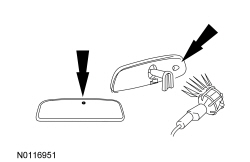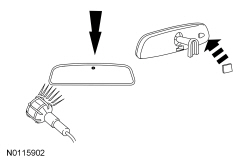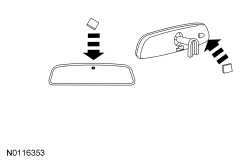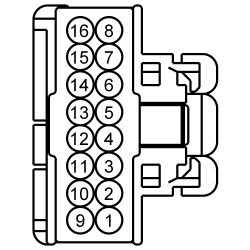- Ignition ON.
- Move the selector lever through the entire range.
- Do the reversing lamps illuminate only in REVERSE?
GO to G2 .
No
REFER to Section 417-01 to diagnose the reversing lamps.
- Visually verify the forward and rearward facing sensors are not blocked. Sources of blockage can include:
- stickers, window decals or tags.
- fold-down screens for TVs or DVD players.
- non- OEM window tinting.
- Were either of the sensors blocked?
If possible, REMOVE the blockage. If the blockage cannot be removed, ADVISE the customer that the blockage will effect the correct operation of the interior auto-dimming mirror.
No
GO to G3 .
- Use a bright lamp to illuminate the forward facing sensor and the rearward facing sensor. The mirror should adjust to a high reflectance mode (mirror will be clear).
- Did the mirror adjust to the high reflectance (clear) mode?

GO to G4 .
No
INSTALL a new interior mirror. REFER to Interior Rear View Mirror .
- Select PARK.
- Simulate nighttime conditions with glare:
- Cover the forward facing sensor with black electrical tape or other dark material.
- Illuminate the rearward facing sensor. The mirror should darken to a lower reflectance mode.
- Did the mirror darken to a lower reflectance (darker) mode?
NOTE: Covering the sensor with a finger or hand is not adequate.

GO to G5 .
No
GO to G7 .
- Simulate nighttime conditions without glare:
- Cover the forward facing sensor with black electrical tape or other dark material.
- Cover the rearward facing sensor. The mirror should adjust to the high reflectance mode.
- Did the mirror adjust to the high reflectance (clear) mode?
NOTE: Covering the sensor with a finger or hand is not adequate.

GO to G6 .
No
GO to G7 .
- Simulate nighttime conditions with glare:
- Cover the forward facing sensor with black electrical tape or other dark material.
- Illuminate the rearward-facing sensor.
- Select REVERSE.
- Did the mirror adjust to a high reflectance (clear) mode?
NOTE: Covering the sensor with a finger or hand is not adequate.

The system is operating correctly at this time. REVIEW the operation of the interior auto-dimming mirror feature with the customer.
No
GO to G7 .
- Ignition OFF.
- Disconnect: Interior Mirror C911.
- Ignition ON.
- Measure the voltage between:
- Is the voltage greater than 11 volts?

| Positive Lead | Negative Lead | ||
| Pin | Circuit | Pin | Circuit |
| C911-1 | CBP32 (GN/VT) | — | Ground |
GO to G8 .
No
VERIFY that BCM fuse 32 (15A) is OK. If OK, REPAIR the circuit. If not OK, REFER to the Wiring Diagrams manual to identify the possible causes of the circuit short.
- Ignition OFF.
- Measure the resistance between:
- Is the resistance less than 3 ohms?

| Positive Lead | Negative Lead | ||
| Pin | Circuit | Pin | Circuit |
| C911-4 | GD233 (BK) | — | Ground |
GO to G9 .
No
REPAIR the circuit.
- Ignition ON.
- Select REVERSE.
- Measure the voltage between:
- Is the voltage greater than 11 volts?
| Positive Lead | Negative Lead | ||
| Pin | Circuit | Pin | Circuit |
| C911-9 | CLS28 (BU/WH) | — | Ground |

INSTALL a new interior mirror. REFER to Interior Rear View Mirror .
No
REPAIR the circuit.